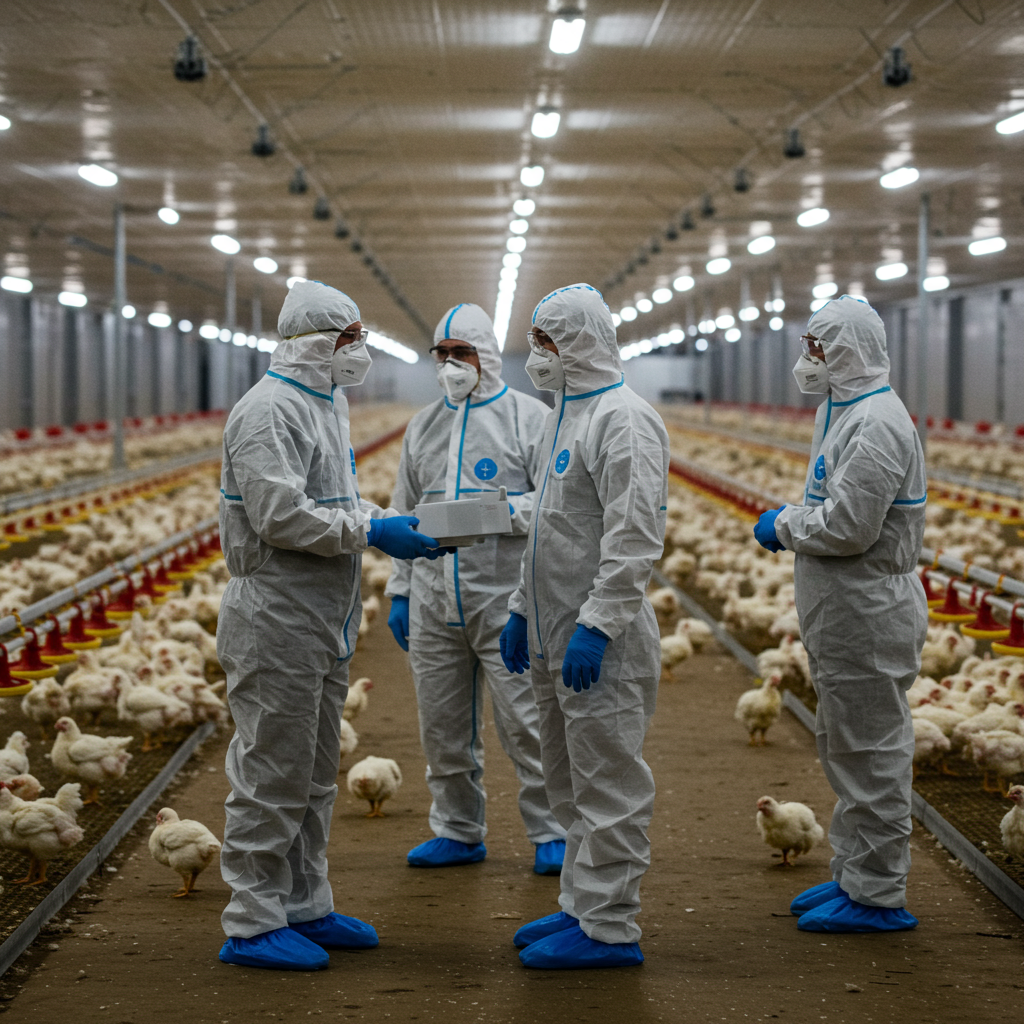The United States faces an alarming resurgence of H5N1 avian influenza, commonly known as bird flu, as outbreaks sweep through poultry populations. In just the past 30 days, over 3.5 million chickens, turkeys, and ducks have been culled nationwide. This drastic measure comes amid a concerning backdrop: a significantly scaled-back federal response to what experts warn is a mounting public health and economic threat. The virus, carried by migrating wild birds, is now spreading rapidly, creating a precarious situation for commercial farms, backyard flocks, and potentially, human populations. This article delves into the escalating crisis, the challenges in containment, and the critical implications of reduced federal oversight.
Avian Influenza Explodes Across U.S. Poultry Farms
The H5N1 bird flu virus is on a relentless march, posing an immediate danger to the nation’s poultry industry. In a swift and devastating 30-day period, 66 commercial poultry flocks were hit, necessitating the destruction of more than 3.5 million birds. This marks a sharp increase in cases compared to the calmer summer months. Experts attribute this rapid acceleration to wild birds moving south for winter, acting as unwitting carriers of the H5N1 virus. When these infected wild birds interact with domestic or commercial poultry, the virus can spread with alarming ease.
Geographically, states in the central U.S. are currently experiencing the most intense outbreaks. However, based on predictable migratory patterns, scientists anticipate a wider spread to other regions soon. The economic repercussions extend far beyond the immediate loss of livestock. The previous year’s outbreaks already demonstrated the potential for soaring egg prices and disruptions to the food supply chain. Virologist Seema Lakdawala from Emory University highlights the gravity of the situation, stating, “Absolutely we’re going to see human infections, just like we did a year ago.” This chilling prediction harks back to nearly 70 human cases and one death reported in the U.S. last year.
The Alarming Gap in Federal Surveillance and Communication
A critical concern for influenza researchers is the diminishing visibility into the virus’s spread among both animals and humans. This lack of clear insight stems from a significant reduction in the federal government’s surveillance and communication efforts. Wendy Puryear, a virologist at Tufts University, points to a dismantling of essential infrastructure. “Much of that infrastructure has been either completely closed down or significantly hampered,” she explains. These setbacks, she notes, are a direct result of staffing and funding cuts, early retirements, and policy shifts under the Trump administration.
Puryear vividly recalls a recent meeting where colleagues, one after another, announced the forced halt of their H5N1-related human studies due to funding cuts. This situation, she describes, was “pretty depressing.” The flow of vital genetic sequencing data from federally-run labs, crucial for tracking viral evolution, has also slowed to a trickle. Dr. Keith Poulsen, who leads the Wisconsin Veterinary Diagnostic Laboratory, confirms this, even pre-dating the recent government shutdown. He emphasizes that staff losses at the U.S. Department of Agriculture (USDA) and new requirements for “pre-approved” communication with scientists create significant obstacles.
The government shutdown only compounded these vulnerabilities. Regular meetings of the veterinary lab network, responsible for crucial testing, ceased. Poulsen starkly warns, “The shutdown just kind of pours gas on a smoldering fire and makes us vulnerable.” He underscores the broader implication, calling it “a national security issue.” While the USDA and Department of Health and Human Services (HHS) maintained that critical services and the CDC’s influenza team remained unaffected and ready for urgent threats, experts on the ground paint a different picture, highlighting real-world consequences of reduced capacity.
Containing H5N1: A Persistent Challenge on Dairy Farms
Beyond poultry, the H5N1 virus has also posed challenges for dairy farms. A USDA program established during the Biden administration still aims to detect bird flu in dairy milk. Rules also mandate cattle testing before interstate movement. Despite these measures, the actual extent of routine cattle testing remains uncertain. Some experts, including Lakdawala, speculate that reported declines in cases might simply reflect a lack of adequate testing. This raises concerns about the true prevalence of the virus in dairy herds.
Lakdawala’s team’s research offers a sobering look into the difficulty of eradicating the virus on farms. Their findings indicate H5N1 is pervasive. It can be found in the air of milking parlors, on equipment, and even in waste streams used for cleaning facilities. Cows, even those showing few or no symptoms, are “expelling it in their milk at such high levels.” This creates an environment where “there is so much virus in the environment, these cows are bombarded with it. Of course, they’re going to become infected.” This high viral load not only impacts animals but also poses a direct risk to farm workers.
Protecting Farm Workers: An Unmet Need for Testing
Farm workers represent the highest-risk group for catching and potentially spreading the H5N1 virus. Scientists are clear: conditions on infected cattle farms present a significant risk. Workers are essentially breathing in aerosolized H5N1 particles, which remain infectious in the air. While the currently circulating H5N1 strain hasn’t developed mutations for easy human-to-human transmission, the constant environmental exposure raises serious concerns for those working closely with infected animals.
Human cases, when they occur, are often mild. They can manifest as eye infections or other easily overlooked symptoms. This makes robust data collection for potential asymptomatic infections incredibly difficult but crucially important for guiding public health responses. A small study from the previous year, for instance, found evidence of past bird flu infection in 7% of dairy workers in Michigan and Colorado. In Minnesota, where dozens of farm outbreaks have occurred since mid-September, state epidemiologist Karen Martin is monitoring approximately 35 exposed individuals. She expresses deep concern about sustaining the necessary resources for ongoing response efforts.
However, a significant hurdle in testing farm workers is their demographic, often including undocumented individuals. Bethany Boggess Alcaulter from the National Center for Farmworker Health notes that fears about immigration enforcement have intensified, leading to a reluctance to get tested. A recent survey of several hundred workers in three states revealed that about 20% experienced symptoms concurrently with sick animals on their farms, yet most were never tested. This lack of comprehensive testing creates dangerous blind spots in public health efforts.
Dr. Nirav Shah, who previously spearheaded bird flu response efforts under President Biden, acknowledges that the CDC’s decision to downgrade its emergency response earlier in the year might have been justifiable. However, he strongly argues that this should not have compromised the critical work of monitoring the virus and responding effectively on the ground. Shah issues a stark warning, calling it “a dangerous game to play when it comes to something like pandemic influenza” to “bank on the fact that there might not be anything.” The pervasive presence of H5N1 on farms demands sustained vigilance and a robust public health infrastructure, not a scaled-back one.
Frequently Asked Questions
What is H5N1 bird flu and why is it surging in the U.S. poultry industry?
H5N1 bird flu, or highly pathogenic avian influenza, is a viral disease primarily affecting birds. Its current surge in the U.S. poultry industry is largely due to wild migratory birds carrying the virus as they fly south for winter. These wild birds can easily transmit H5N1 to commercial and backyard poultry flocks when they mix, leading to widespread outbreaks. In the last 30 days, over 3.5 million chickens, turkeys, and ducks were destroyed in response to these rapidly increasing outbreaks.
How has the federal response to bird flu outbreaks been impacted, according to experts?
Experts report a significant scaling back of the federal response to H5N1 bird flu outbreaks. This includes reduced surveillance capabilities, communication hurdles, and funding cuts that have forced researchers to halt H5N1-related human studies. Scientists also note a slowdown in the genetic sequencing data flow from federally-run labs. Concerns were exacerbated by a government shutdown, which stopped crucial veterinary lab meetings. Experts warn that these cutbacks leave the U.S. vulnerable, characterizing it as “a dangerous game” in pandemic preparedness.
What are the risks of H5N1 bird flu to humans and farm workers, and how is testing affected?
While the H5N1 strain circulating has not shown mutations for easy human-to-human transmission, there’s a clear risk of spillover, with nearly 70 human cases and one death reported last year. Farm workers face particular danger due to high viral loads on dairy farms, where they can inhale aerosolized virus particles. Testing for human cases is problematic because symptoms are often mild and easily overlooked, like eye infections. Additionally, fears of immigration enforcement among undocumented farm workers create significant challenges for robust testing and data collection.
Sustaining Vigilance in the Face of a Persistent Threat
The H5N1 bird flu crisis represents a multi-faceted challenge, impacting agricultural economies, public health, and national security. The rapid surge in poultry outbreaks, coupled with the documented risks to human health, demands a comprehensive and proactive approach. Experts are unified in their call for robust surveillance, transparent communication, and sustained funding for research and response. The insights from virologists and public health officials underscore the critical importance of these efforts, especially in safeguarding vulnerable populations like farm workers. Moving forward, a renewed commitment to pandemic preparedness and an agile, well-resourced federal response are not merely advisable, but essential to mitigate the potential fallout of this persistent avian influenza threat.




